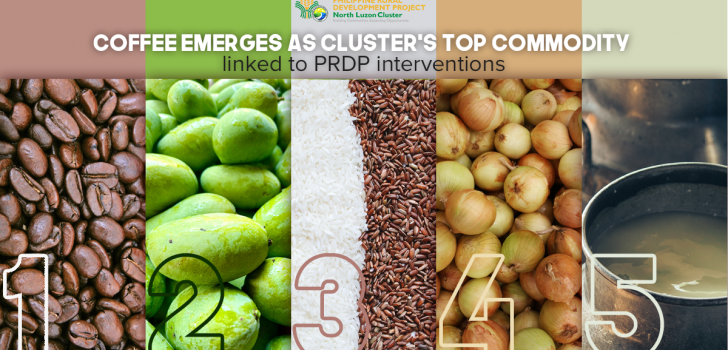
Coffee emerges as cluster’s top commodity linked to PRDP interventions
Out of the twenty-four (24) agri-fishery commodities covered in the Provincial Commodity Investment Plans (PCIPs) of the 23 provinces and a city in the North Luzon Cluster, coffee emerged as the leading commodity with the highest total cost of intervention support from the Department of Agriculture – Philippine Rural Development Project (DA-PRDP).
Thirty-five (35) subprojects, comprising infrastructure and enterprise, amounting to PhP 2.77 billion are implemented, which have played a vital role in enhancing the overall coffee value chain, benefitting both coffee growers and the local coffee industry in the cluster.
The said interventions are largely found in the Cordillera Administrative Region (CAR) followed by the Cagayan Valley region. These regions have a rich coffee heritage and are known for producing high-quality Arabica and Robusta coffee varieties.
CAR takes up 77% of the total cost with PhP 2.12 billion covering 26 subprojects while Cagayan Valley received PhP 646.14 million worth of subprojects, totaling nine (9).
Top five commodities
Mango comes next after coffee on the list with three regions sharing the total cost of subprojects in support of the mango commodity. Ilocos region topped the list with 16 subprojects amounting to Php 1.20B (78%), followed by Central Luzon with 9 worth PhP 296.86M (20%), and CAR with 2 SPs cost PhP 36.8M (2%).
It is followed by Rice (aromatic and pigmented) with Php 1.51B worth of total subprojects, including 16 SPs worth PhP 802.51M (53%) in CAR, 21 SPs worth PhP 627.9M (42%) in Ilocos Region, and 3 SPs worth PhP 81.27M (5%) in Central Luzon.
Onion is the fourth among the commodities with the highest total cost of intervention with 24 SPs worth Php 1.50B. Central Luzon has the highest cost with PhP 1.13B for 17 subprojects (76%), followed by the Ilocos Region with PhP 347.46M (6 SPs) or 23%, and Cagayan Valley with PhP 16.46M (1 SP) or 1%.
Following onion is Dairy with 20 implemented interventions worth PhP 1.67B. The Cagayan Valley region accounts for 97% of the investments with 18 SPs worth PhP 1.13B, followed by Central Luzon with 2 SPs (PhP 34.84M) or 3%.
Strategic Interventions
One of the key areas of intervention implemented by the DA-PRDP to support the production of the commodities indicated in PCIP is the improvement of farm-to-market roads.
Opening, upgrading, and rehabilitating road networks have helped achieved better transportation of harvests from remote production areas to processing facilities and markets. This has resulted in reduced transportation costs, decreased post-harvest losses, and allowed farmers to access broader markets, which led to improved income opportunities.
PRDP also made a significant contribution to the establishment of post-harvest facilities and processing centers. These facilities have aided farmers with the necessary infrastructure to properly sort, dry, and process their crops. Likewise, these interventions help ensure high-quality production, enhancing the market competitiveness of the farmers’ products.
Furthermore, PRDP also invested in improving the capacity of farmers through various training activities. Through these skills-training initiatives, PRDP enables them to improve productivity and produce quality.
With PRDP’s commitment to agricultural development, more farmers of various commodity industries can benefit from all the infrastructure and enterprise subprojects being implemented, driving sustainable and economic growth in the countryside. (Ericson M. Guiao, PSO NL InfoACE)
